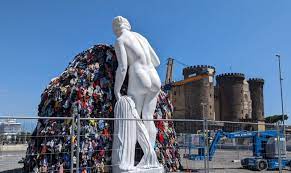
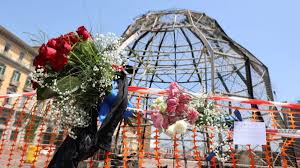
THE VULNERABILITY OF ITALIAN ART WORKS
The recent destruction of a version of an important work of contemporary art, the Venere degli Stracci (Venus of the Rags), the controversial masterpiece of Arte Povera by Michelangelo Pistolesi, which had been set up in Naples main city square, has caused an outcry. The work, which according to the artist represents “the disorder of modern life”, was set deliberately on fire and was reduced to a pile of cinders.
The citizens of Naples have treated the destruction of the installation as a death to be mourned and continue to drape flowers and messages of regret on the empty framework that supported the composition.
Unfortunately, this is only the last in a list of wilful devastation of Italian art and antiquities. Carving initials on the venerable stones of the Colosseum may seem a minor crime in comparison but authorities are worried that it may set off a trend among the 19 thousand + plus tourists who visit the amphitheatre every day.
Unfortunately, monuments and street installations are vulnerable and difficult to safeguard. Some years ago, again in Naples, the Montagna di Sale (Mountain of Salt) by Mimmo Paladino was destroyed during the New Year revels. The artist has subsequently reconstructed his oeuvre in Trapani at the cultural centre of the Foundation Orestiadi at Baglio di Stefano Gibellina (Sicily). The “Capuzzelle” (Skulls) by Rebecca Horn met a similar fate, as did Richard Serra's “Spiral”. And no-one can forget the horrifying incident in 1972 when Australian tourist Laszlo Toth attacked Michelangelo's Pieta with a hammer in a crowded St. Peter's Basilica under the horrified gaze of visitors and custodians. Toth, who was diagnosed as severely disturbed, was interned for a while and then subsequently repatriated.
MSTENHOUSE
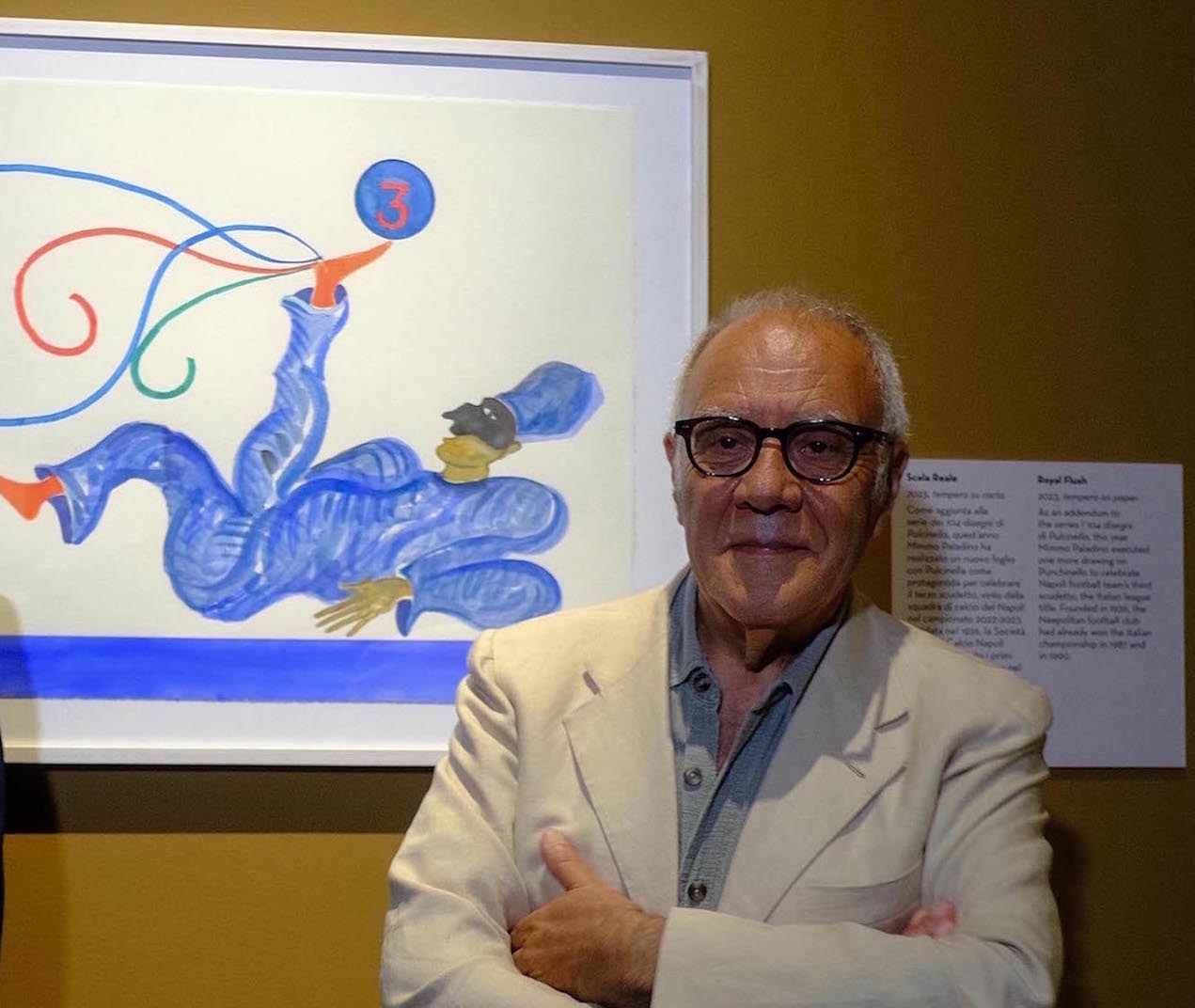
PULCINELLO CELEBRATES NAPLES CUP
The traditional “mask” Pulcinello, symbol of the people of Naples, could not have been excluded from the exuberant and joyful celebrations of the recent win of the Napoli team in this year's Italian Football championship. This is the third time the home team has attained brought the cup.
Artist Mimmo Paladino, a leader of the Italian Neo-Impressionism movement, has included Pulcinello in the festivities by portraying him in his latest work, entitled “Scala Reale” (Royal Flush – or the winning hand at poker) in which the clown is shown playing with a football.
The drawing joins the exhibition of 104 Pulcinello figures by Paladino currently on show at the Royal Palace of Naples.
The exhibition is set up in the Galleria del Genovese and will run until the 3rd October 2023. Until the 15th September 2023 part of the cost of the entrance ticket (which is included in the Royal Palace entry fee) will be used to fund recovery and restoration of art works damaged during the recent Italian flooding.
Info: Tel. (Press Office) +39.337.929093 www.palazzorealedinapoli.org

VICTORY MEETS THE BOXER AT BRESCIA
The Winged Victory, symbol of Brescia, (Lombardia), meets the Roman Boxer at Rest in a rare confrontation at the Archaeological Park of Brescia Romana. The two bronze sculptures, masterpieces of Hellenistic and Roman art, will keep each other company until the 29th October 2023, in the Hall of the Capitolium in the UNESCO listed Monumental Area San Salvatore-Santa Giulia Monastery, first founded in 753 AD by Desiderius, future King of the Lombards.
The evocative installation accompanying the exhibition has been projected by Spanish architect Juan Navarro Baldeweg.
The 1st century AD Winged Victory was discovered during the excavations at the site of the Capitoleum of Ancient Brixia and is part of the Santa Giulia Monastery Collection , while the Ancient Greek “Boxer at Rest” is on loan from Palazzo Massimo alle Terme, Rome. The sculpture is considered to be one of the finest examples of Hellenic art is believed to date from somewhere between the 4th and 2nd century BC.
M.STENHOUSE
Info: Tel.+39.030.2977833 www.bresciamusei.com cup@bresciamusei.com
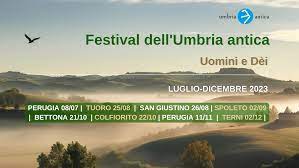
THE SECRET LIFE OF ANCIENT UMBRIA
The Festival of Ancient Umbria widens its scope this year to encompass seven major centres within the territory of Italy's most mysterious central region. This year's edition, spread over six months of events and conferences involving eminent historians and anthropologists, is entitled. “Uomini e Dei” (Men and Gods) and sets out to explore the spiritual world of the Italic peoples, the Etruscans and the early Romans, the three different populations that once inhabited the region.
After last year's highly successful launch, the 2023 version was inaugurated on the 8th July 2023 at the National Archaeological Museum of Perugia, set in the historic central area, known as the “Isola di San Lorenzo” (Island of St. Lawrence) even though no island exists. The word is simply a corruption of the Latin “ Insula” (meaning a block of houses).
The second stage of the Festival will take place at a real lake, the town of Tuoro sul Trasimeno at Lake Trasimeno (25th August 2023), scene of an epic defeat of the Romans by Hannibal's invading troops and continues the following day at San Giustino in the National Archaeological Museum of the Villa di Pliny. The third event, on the 2nd September 2023, will be at the town of Spoleto, seat of the celebrated annual International Arts Festival. October 21-22 involves the Museum of the Citta di Bettona, listed as “one of the most beautiful borghi in Italy”, as well as the Archaeological Museum of Colfiorito. Back to Perugia on November 11th at the Chapter Museum of the Cathedral of San Lorenzo, built over the remains of an Etruscan temple.
The itinerary concludes on the 2nd December 2023 at the Archaeological Museum of the town of Terni
Every phase of the Festival is accompanied by a series of lectures by leading experts in the field, who will reveal the secrets of the spiritual life of the three ancient races and their relationship with the supernatural world and the afterlife.
The lectures will also be available on internet and in podcast versions
-
STENHOUSE
Info: Tel. 0039.334.2573601 www.festivalumbriantica.it
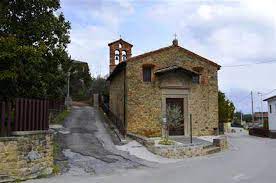
PERUGINO: BEGINNING AND END
After the major exhibition held earlier this year in the National Gallery of Umbria, Perugia, the commemoration of Perugino's fiftieth anniversary follows on at both Citta della Pieve (his birthplace) and Fontignano, where he contracted the deadly bubonic plague and died in 1524.
Pietro Cristoforo Vannucci (better known by his nickname “Perugino”- a person from Perugia), the artist who was to revolutionize Italian renaissance art was born in the small town of Città della Pieve, which still conserves several of his masterpieces. The exhibition, rather quaintly entitled “- and he was baptised Pietro”, opened on the 1st July and runs until the 30th September 2023, is divided between three prestigious historical venues – the Palazzo della Cogna, the Civic Diocese Museum of Santa Maria dei Servi, and the Oratory of Santa Maria dei Bianchi. One entry ticket covers all three venues.
The little known village of Fontignano, instead offers a more poignant visit to see the artist's tomb - a marble urn on a pedestal set up in 1929 when his remains were discovered buried near the small church of the Annunciation where the artist had his workshop during the last years of his life. According to Giorgio Vasari, the biographer of the Italian Renaissance artists, Perugino was not given burial inside the church because he was an atheist. The walls of the church were originally covered in five frescoes painted by the maestro, but four were removed and sold in the 19th century. The remaining one, damaged by damp and some clumsy attempts at restoration, features a Madonna and Child and is dated the year before Perugino's death. The fragment has been chosen to illustrate a commemorative stamp issued by the Italian Post Office in honour of the event.
Info: www.peruginocittadellapieve.it
www.umbriatourismo.it/it/-/la-tomba-del-perugino-a-fontignano
Fontignano – La Chiesa dell'Annunziata: Tel.+39.340.23734406
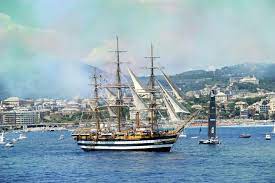
ITALY'S TALL SHIP AMERIGO VESPUCCI WORLD TOUR
Italy's iconic full-rigged sailing ship, the “Amerigo Vespucci” set sail from Genoa on the 1st July 2023 on a world tour to promote research and protection of the marine eco system. The 20-month planned itinerary touches 31 ports in the five continents and will terminate in February 2025.
The “Amerigo Vespucci” was built in the shipyards of Castelammare di Stabia, Naples, in 1931 and was named after the 15th century Florentine explorer who was the first, after Cristopher Columbus, to reach the “New World” and to realise that it was, in fact, an entire continent. A gilded statue of him features as the ship's figurehead.
The three-masted tall ship is used as a training ship for Italian naval cadets and has often participated in promotional and eco-sustainable activities, promoted by world organizations like UNESCO and UNICEF.
The Genoa send-off ceremony included a spectacular flyover by the Frecce Tricolori (the Italian Air Force acrobatic team).
Info: www.navalnews.com
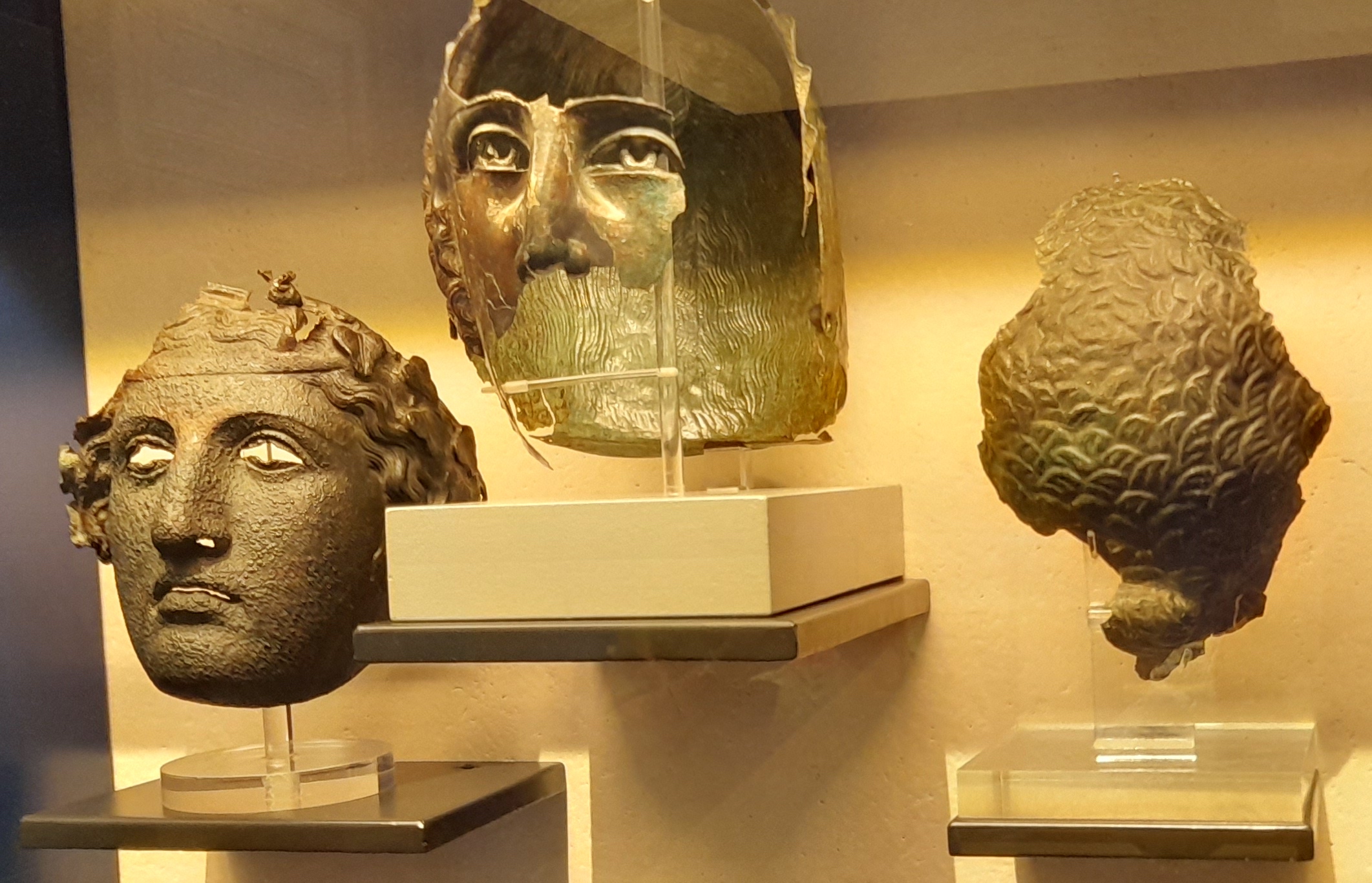
ANCIENT BRONZE OFFERINGS TO THE GODS (SAN CASCIANO DEI BAGNI)
The cache of bronze offerings discovered last November 2022 at the spa resort of San Casciano dei Bagni (Tuscany) is considered so exceptional that the finds have been put on public display for the first time at the Quirinale Presidential Palace in Rome – a rare privilege accorded only to very special exhibits, such as the two celebrated bronze warriors recovered from the seabed in 1972 and known as the Riace Bronzes.
The exhibition, entitled, “Gli Dei Ritornano” (The Gods Return), features some 20 statues and statuettes, as well as thousands of ex-voto anatomical images and coins, dating from the Etruscan era to the advent of Christianity. A particularly unusual find is the bronze thunderbolt representing the one recorded as having struck the site of the Baths in the 1st century AD, confirming the sacredness and healing powers of the waters.
According to Prof. Jacopo Tabolli, Professor of Etruscology at the University for Foreigners at Siena who led the site archaeological team, the exceptional state of conservation of the ex-votos is thanks to the fact that the bronzes were submerged in the mud at the foot of a sacred well at the ancient healing centre fed with natural warm mineral water.
The exhibition will remain at the Quirinale until the 25th July 2023 and then again between the 2nd September and 29th October 2023, after which the collection expects to be moved to a new permanent museum in San Casciano dei Bagni, opening planned for the end of the year, according to the Italian Ministry of Culture.
Info: www.beniculturale.it
Per visite: Tel. +39.0578.20915 museocivicochiusi@gmail.com
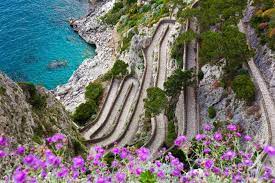
CAPRI REOPENS CELEBRATED VIA KRUPP
Good news for visitors to the island of Capri who want to see more than the Blue Grotto and the high class shopping centre around the Piazzetta: Via Krupp, one of Capri's most spectacular sights, has re-opened again, after a closure lasting nine years.
The narrow paved track, containing 1,300 meters of twists and turns, snakes down the 1000 metre-high cliff face from the public gardens “of Augustus” to the beach at Marina Piccola.
Built by architect Emilio Mayer and financed by the German steel magnate Alfred Krupp, the Via Krupp opened in 1902. Hailed as a miracle of road engineering, it instantly became one of the most popular island excursions. Unfortunately, the fragmentary nature of the Capri cliffs meant that it was frequently blocked by falling rocks and landslides. The last, most serious one, was some ten years ago. The road was proclaimed dangerous and subsequently closed off until extensive maintenance work on the cliff face was carried out to ensure future safety.
Finally, Via Krupp is now once more open to the public every day between June and September and throughout the Christmas holidays. The rest of the year will be reserved for inspection, dealing with potentially dangerous fissures in the cliffs and maintenance work.
Info: www.capri.it
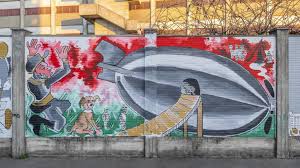
MILAN'S CITADEL OF ARCHIVES AND ART
Milan's monumental Cittadella degli Archivi (citadel of Archives) has continued its policy of promoting street art with a new display of wall paintings covering 600 sqm along its street frontage with the theme: “Dai borghi alla citta, dalla citta ai quartieri” {borghi are small historic towns). The initiative (first introduced five years ago) has become a pole of attraction for citizens and visitors alike, giving the historic archives a fresh look and a contemporary dimension.
The Cittadella city archive contains over 1.5 million documents of historic and cultural interest in around 70 kms of linear shelving space and dates back to 1923 when Mussolini amalgamated eleven municipalities bordering on Milan, turning them into “quarters” and thus doubling the city's metropolitan area.
The present exhibition, organized by the Isorropia Homegallery non profit organization, features the work of 14 artists and aims to underline the individual identity that these former little towns have preserved.
Info: Tel. +39.02.88445523 www.beniculturali.it info@isorropiahomegallery.org

MYSTERIOUS ROMAN SWORD FOUND AT APPIA ANTICA
The Palazzo Chigi museum in Ariccia (Lazio, near Rome) has recently acquired a unique treasure, that had been lost for several decades. The short Roman sword, lavishly decorated and complete with its ivory scabbard, was first discovered in 1976 near a tomb on the Appia Antica road in the valley of Ariccia during an excavation campaign. However, it was put aside and subsequently languished forgotten for twenty years in the vast deposits of the Superintendence of Cultural Heritage.
Giuseppina Ghini, the former head of the area archaeology department, recognized the sword as a unique and invaluable piece during a routine visit of inspection in 1994 and had the sword transferred to the expert hands of the restoration team at the Central Institute for Restoration, Rome, who recovered much of its original splendour.
The 53 cm-long sword has many unusual features, including an ivory hilt decorated with four miniature masks, protected by an ivory scabbard. Experts think that, since the weapon was not suitable for battle, it probably belonged to an actor and was used in theatrical productions. Mysteriously, the sword was found underneath – and not inside - a sarcophagus that came to light when an ancient tower collapsed on the tract of the Old Appian Way under the town of Ariccia. The tomb contained a skeleton wrapped in a purple woollen cloak and some grave goods.
The Old Appian Way has applied for recognition as a UNESCO World Heritage Site.
MSTENHOUSE
Info: Tel. +39.069330053 www.palazzochigiariccia.it
<< Previous 1 2 3 4 5 6 7 8 9 10 11 12 13 14 15 16 17 18 19 ... 21 ... 23 ... 25 ... 27 ... 29 ... 31 ... 33 ... 35 ... 37 ... 39 ... 41 ... 43 ... 45 ... 47 ... 49 ... 51 ... 53 ... 55 ... 57 ... 59 ... 61 ... 63 ... 65 ... 67 ... 69 ... 71 ... 73 ... 75 ... 77 ... 79 ... 81 ... 83 ... 85 ... 87 ... 89 ... 91 ... 93 ... 95 ... 97 ... 99 ... 101 ... 103 ... 105 ... 107 ... 109 ... 111 ... 113 ... 115 ... 117 ... 119 ... 121 ... 123 ... 125 ... 127 ... 129 ... 131 ... 133 ... 135 ... 137 ... 139 ... 141 ... 143 ... 145 ... 147 ... Next >>



